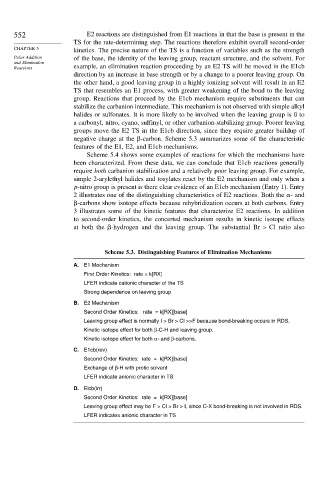Page 571 - Advanced Organic Chemistry Part A - Structure and Mechanisms, 5th ed (2007) - Carey _ Sundberg
P. 571
552 E2 reactions are distinguished from E1 reactions in that the base is present in the
TS for the rate-determining step. The reactions therefore exhibit overall second-order
CHAPTER 5 kinetics. The precise nature of the TS is a function of variables such as the strength
Polar Addition of the base, the identity of the leaving group, reactant structure, and the solvent. For
and Elimination
Reactions example, an elimination reaction proceeding by an E2 TS will be moved in the E1cb
direction by an increase in base strength or by a change to a poorer leaving group. On
the other hand, a good leaving group in a highly ionizing solvent will result in an E2
TS that resembles an E1 process, with greater weakening of the bond to the leaving
group. Reactions that proceed by the E1cb mechanism require substituents that can
stabilize the carbanion intermediate. This mechanism is not observed with simple alkyl
halides or sulfonates. It is more likely to be involved when the leaving group is ß to
a carbonyl, nitro, cyano, sulfinyl, or other carbanion-stabilizing group. Poorer leaving
groups move the E2 TS in the E1cb direction, since they require greater buildup of
negative charge at the -carbon. Scheme 5.3 summarizes some of the characteristic
features of the E1, E2, and E1cb mechanisms.
Scheme 5.4 shows some examples of reactions for which the mechanisms have
been characterized. From these data, we can conclude that E1cb reactions generally
require both carbanion stabilization and a relatively poor leaving group. For example,
simple 2-arylethyl halides and tosylates react by the E2 mechanism and only when a
p-nitro group is present is there clear evidence of an E1cb mechanism (Entry 1). Entry
2 illustrates one of the distinguishing characteristics of E2 reactions. Both the - and
-carbons show isotope effects because rehybridization occurs at both carbons. Entry
3 illustrates some of the kinetic features that characterize E2 reactions. In addition
to second-order kinetics, the concerted mechanism results in kinetic isotope effects
at both the -hydrogen and the leaving group. The substantial Br > Cl ratio also
Scheme 5.3. Distinguishing Features of Elimination Mechanisms
A. E1 Mechanism
First Order Kinetics: rate = k[RX]
LFER indicate cationic character of the TS
Strong dependence on leaving group
B. E2 Mechanism
Second Order Kinetics: rate = k[RX][base]
Leaving group effect is normally I > Br > Cl >>F because bond-breaking occurs in RDS.
Kinetic isotope effect for both β-C-H and leaving group.
Kinetic isotope effect for both α- and β-carbons.
C. E1cb(rev)
Second Order Kinetics: rate = k[RX][base]
Exchange of β-H with protic solvent
LFER indicate anionic character in TS
D. Elcb(irr)
Second Order Kinetics: rate = k[RX][base]
Leaving group effect may be F > Cl > Br > I, since C-X bond-breaking is not involved in RDS.
LFER indicates anionic character in TS

